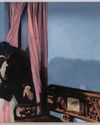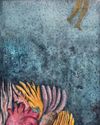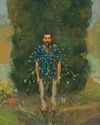試す 金 - 無料
When a Painting is a ‘Thank You' Note
Art India
|July 2021
The Pithoro murals invoke gods and goddesses even as they accommodate landscapes with a pantheon of real and imaginary creatures, informs Sandhya Bordewekar.

Many tribal communities that are conscious of their natural environment have evolved lifestyle practices that protect and sustain it. In a world that is moving too fast, one has to acknowledge the tenacity with which they often resist the temptation to accept the compulsions to homogenise and erase their cultural uniqueness. When they are faced with trouble in their lives, such as prolonged illnesses in the family, failed crops, childlessness, business losses, unresolvable family feuds, they turn to their deities and seek their support and succour. Over centuries, the monumental Pithoro painting has emerged as a tool of appeasement, a ‘thank you’ note to the gods for relieving them of their misery. Once the problem is sorted, the family is duty-bound to fulfil the committed vow at the earliest. The Pithoro can also be painted in anticipation of good fortune or as insurance against future calamities.
The name Pithoro comes from Babo Pithoro or Pithorodev, the god who is worshipped by the large Rathwa community in south-eastern Gujarat and western Madhya Pradesh. The painting is not just an instrument of visual delight; it is a powerful representation of gods and goddesses in their homes. It is crowded with images of Rathwa life.
The painters or Lakharas are always male – they hail from families in which this skill has been handed down across generations. None of them has a formal training in painting, though a few of them have made it to art schools in recent years. However, they prefer the traditional mode of painting, with a minimal influence of art school learning.
このストーリーは、Art India の July 2021 版からのものです。
Magzter GOLD を購読すると、厳選された何千ものプレミアム記事や、10,000 以上の雑誌や新聞にアクセスできます。
すでに購読者ですか? サインイン
Art India からのその他のストーリー

Art India
Parts, Wholes And The Spaces In Between
Sonal Sundararajan introduces Samira Rathod's free-spirited and rebellious explorations in the world of architecture, furniture and design.
6 mins
April 2023

Art India
"The Fine Art of Going to the Pictures."
Dr. Banerjee in Dr. Kulkarni's Nursing Home at Chemould Prescott Road brings together 26 paintings featuring a series of dramatic scenes from Hindi and Bengali films. In conversation with Abhay Sardesai, artist Atul Dodiya talks about childhood trips to movie halls, painted figures gripped by tension, and the closeness and remoteness of cinematic images.
10 mins
April 2023

Art India
"To Finally Have Something of Your Own to Mine."
Dayanita Singh is the recipient of the coveted 2022 Hasselblad Award. Keeping the photograph at the centre, she speaks to Shreevatsa Nevatia about books, book objects, photo novels, exhibitions and museums.
6 mins
April 2023

Art India
OF DIVINE LOSS
Shaurya Kumar explores the relationship between the subject and object of devotion, finds Aranya.
3 mins
April 2023

Art India
THE PAST AND ITS SHADOWS
Neha Mitra visits two shows and three artists in Mumbai.
3 mins
April 2023

Art India
FORCE OF NATURE
Alwar Balasubramaniam dwells on absences and ephemeralities in his new work, states Meera Menezes.
3 mins
April 2023

Art India
SHAPES OF WATER
Devika Sundar's works delineate the murky, malleable boundaries between the human body and the organic world, says Joshua Muyiwa.
3 mins
April 2023

Art India
INTIMATIONS OF INTIMACY
Sunil Gupta shares his journey with Gautami Reddy.
5 mins
April 2023

Art India
THE FRACTURED PROSPECT
Nocturnal landscapes as ruins in the making? Adwait Singh looks at Biraaj Dodiya's scenes of loss.
5 mins
April 2023

Art India
TEETERING BEYOND OUR GRASP
Meera Menezes traces Mahesh Baliga's journey from Moodabidri to London.
5 mins
April 2023
Translate
Change font size
